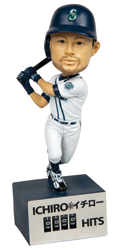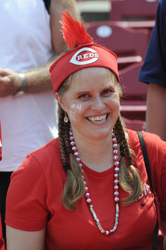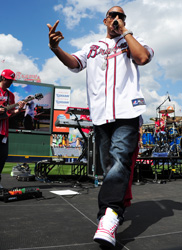MLB clubs adjusted their game-day promotions strategies this season by shifting much of their distribution of bobbleheads back to weeknights, increasing the number of weekend festivals and concerts, and giving away more traditional items.
Club officials and vendors said the changes were done to help boost attendance throughout the week and maximize exposure for a sponsor base that has become increasingly involved in the promotions and giveaway process.
T-shirts, headwear and bobbleheads again topped the list of items most frequently given to fans, according to a SportsBusiness Journal analysis of teams’ 2011 promotional efforts, as they have been in each of the seasons since SBJ first started tracking MLB game-day promotions and giveaways in 2002.
Promotions schedule
highlights
Executives at 14 of the 16 MLB clubs interviewed by SportsBusiness Journal said that in 2011 their club increased the number of promotional dates and the total amount spent on those dates, compared with the 2010 season. The other two clubs said spending remained the same.
An analysis of all 30 MLB teams’ promotional schedules reveals that:
■ Teams combined for 798 giveaway dates this season, an increase of 11 percent over last year, and 39 percent compared with 2008.
■ The teams combined for 1,891 non-giveaway promotions, such as fireworks, discounted parking, etc., up 33 percent over 2010 and double what they were in 2008.
■ A decade ago, many clubs didn’t even release their promotional schedule prior to spring training. This year, some clubs have already placed orders for 2012, and at least one-third of the clubs will have released their lists publicly by the end of this month.
■ Seattle-based BDA, MLB’s preferred premium merchandise provider, has seen its revenue soar 30 percent this year, to “north of $300 million,” according to Jay Deutsch, BDA’s CEO and co-founder.
But as fans’ attitudes toward stadium giveaways have changed in recent years, so have the expectations of teams and their sponsors.
As the 2010 season was winding down, MLB clubs were faced with the reality that more than 30 percent of their seats had gone unfilled, the highest such vacancy rate since 2005. When the planning and ordering process for the 2011 season of promotions and giveaways began, there was no reason to believe attendance patterns were going to suddenly improve.
As a result, most clubs continued to tinker with their promotions strategies. A look at the most recent six years of bobblehead giveaways shows how much MLB teams are constantly adjusting those metrics.
The switch to distributing primarily higher value items (think bobbleheads versus foam fingers) has been around since the Beanie Babies craze of the late 1990s. But in 2010 several clubs made the jump to fill their Saturdays with premium giveaways, rather than doing so on presumably slower weeknights.
A number of attendance-challenged teams, such as the Pittsburgh Pirates and Texas Rangers, had begun that change in philosophy prior to 2010. The thinking was that while the overall increase in attendance may be bigger, percentage-wise, on a weeknight that features a promotion, fans and sponsors would get a better experiential payoff by being in the presence of a larger crowd on a weekend. As a result, nearly half of the bobbleheads were doled out on Saturdays in 2010 among all MLB teams, compared with less than one-third in 2009.
That strategy appeared to shift this season, however, as the percentage of bobbleheads given out on Saturdays declined 12 percentage points, and for the first time since at least 2006, such items were more likely to be given out on a weeknight rather than a Sunday.
The Los Angeles Dodgers were one of several clubs that switched from a strictly weekend bobblehead distribution to a totally weeknight schedule in 2011.
“It was simply based on dates we think will need a ticket lift when looking at the schedule preseason,” said Joe Jareck, the Dodgers’ assistant director of public relations. “That is why the bigger giveaways were frequently on Tuesdays and Wednesdays.”
 |
BDA
Strategies shifted on the best nights to give away premium items such as bobbleheads. |
Attendance at the Dodgers’ four bobble nights showed a double-digit increase over non-bobble weeknights.
The Rangers also changed their bobblehead philosophy. In 2009 and 2010, the team scheduled its lone bobble giveaway on a weekend date, and saw a slight bump in attendance compared with similar nights. But this year’s Nelson Cruz bobble was given out on Monday, June 20, when the Houston Astros were in town. The crowd of 41,205 was 28.5 percent higher than the team’s other 10 Monday night home games.
Adjusting the formula
Although variables such as weather, opponent, winning or losing streaks, and group sales make it impossible to create a standard template for all clubs to follow, when viewed over time, clear trends begin to emerge.
“What has become clear over the past decade is that if you are not a team that sells out every game, the answer to the question ‘Does merchandise move the needle on attendance?’… is unequivocally ‘Yes,’” said Jay Deutsch, CEO and co-founder of BDA, MLB’s preferred premium merchandise provider. “And teams that do fill their seats on a regular basis begin to see those promotional products move beyond the ballpark.”
Teams are trying to provide value to sponsors in new ways and have found branded merchandise for retail, drive-to-retail, gift-with-purchase and social media promotions to be effective.
According to one team source, some clubs have found an increase in merchandise per cap sales at team stores during
 |
CINCINNATI REDS
"Spirit hair" was among the quirky products that made the promotional calendar this season. |
ame, by deliberately handing out giveaways, such as a bobblehead, to a limited number of fans. Fans see the item all around them, and decide they want one, too, and go buy it in the team store.
The game-day promotion provides additional revenue streams from sponsors, too. For example, although visitors to Fenway Park last season were again the fans who were least likely to get a stadium freebie, Red Sox sponsors didn’t seem to mind.
Local sponsors of MLB clubs can get bobbleheads and other items made with their company logo and the team marks. So in the case of the Red Sox, the team generates revenue by selling items such as sponsor-branded bobbleheads and caps that typically are game-day giveaways.
“Red Sox partners are far and away the most likely of any MLB club to buy custom-made premium items,” Deutsch said. “They have about 100 sponsors putting their company logo on Red Sox products.”
The 2011 market saw more of the promotions pie being occupied by items that are tried-and-true favorites, proved by the increase in the number of T-shirts and baseball caps handed out.
A standard bobblehead costs $2.50-$3.50, with custom units costing up to $4.50. Several teams said that although rally towels remain popular, the cost of cotton has pushed the price of such an item to about $4.
While teams often leaned on traditional favorites, that’s not to say the giveaway market turned dull in 2011. The
 |
MLB PHOTOS / GETTY IMAGES
Ludacris performs after an Atlanta Braves game in May. The singer also had concerts after Florida Marlins and Los Angeles Angels home games. |
Angels handed out 45,000 Rally Monkey Chia Pets, one of the 832,000 items they gave fans this season. And Cincinnati-based Idegy made the Reds’ “spirit hair,” one of 540,000 freebies dished out by the team in 2011, an 8 percent increase over 2010.
The most significant change among game-day events or non-giveaways was an increase in the number of experiential dates that usually included a Friday or Saturday night pregame fan festival, and carried over into postgame fireworks or a concert. Nine clubs staged a total of 110 such events throughout the season, and nearly every one of them had a title sponsor to underwrite the estimated $5,000-$7,500 weekly cost to stage the events.
MLB ballparks also saw a big increase in concerts that were not tied to the regularly scheduled fan festivals. Acts ranged from state fair favorites .38 Special to Ludacris, who performed after Atlanta Braves, Florida Marlins and Los Angeles Angels home games. And while city ordinances prohibit seven clubs from shooting off fireworks at their ballparks, the remaining 23 clubs staged a total of 195 fireworks shows.
Sponsors still interested
So despite a sluggish economy, the stadium promotions market remains strong.
“The corporations are definitely coming back,” Deutsch said. “But what’s refreshing and challenging at the same time is that sponsors are being much more selective and creative with what they want. Merchandise can be just merchandise, and people can bring it home and feel a connection. And that’s great. But if you equate that to the four or five times your logo gets shown on TV, then it has more than paid for itself.”
PNC Financial Services is the most active financial partner among game-day activators, sponsoring 17 dates at six ballparks, including 85,000 bobbleheads in 2011. PNC always orders several hundred extra figures to pass through for branch promotions, employee incentives and customer giveaways. And in another example of the growing importance of game-day promotions to sponsors, the bank’s various team-level contracts call for at least one premium giveaway per year.
The company has been the primary bobblehead sponsor of the Washington Nationals since 2006, a designation that makes Sonia McCormick, the bank’s vice president of corporate communications, almost giddy.
“Who doesn’t want to sponsor a giveaway that everyone loves to have on their desk?” said McCormick, who said she has 20 bobbles displayed in her office. “Anyone can give away a hat.”






